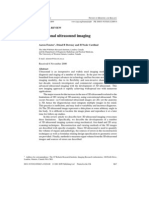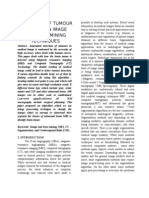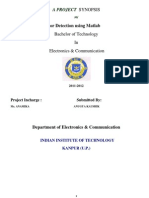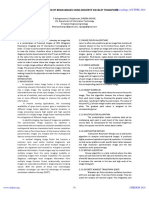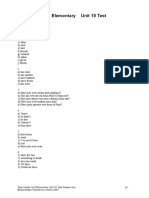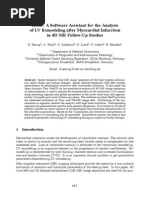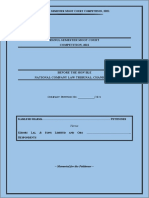Development of 3D Image Reconstruction Based On Untracked 2D Fetal Phantom Ultrasound Images Using VTK
Development of 3D Image Reconstruction Based On Untracked 2D Fetal Phantom Ultrasound Images Using VTK
Uploaded by
David CampoverdeCopyright:
Available Formats
Development of 3D Image Reconstruction Based On Untracked 2D Fetal Phantom Ultrasound Images Using VTK
Development of 3D Image Reconstruction Based On Untracked 2D Fetal Phantom Ultrasound Images Using VTK
Uploaded by
David CampoverdeOriginal Description:
Original Title
Copyright
Available Formats
Share this document
Did you find this document useful?
Is this content inappropriate?
Copyright:
Available Formats
Development of 3D Image Reconstruction Based On Untracked 2D Fetal Phantom Ultrasound Images Using VTK
Development of 3D Image Reconstruction Based On Untracked 2D Fetal Phantom Ultrasound Images Using VTK
Uploaded by
David CampoverdeCopyright:
Available Formats
WSEAS TRANSACTIONS on SIGNAL PROCESSING
Mahani Hafizah, Tan Kok, Eko Supriyanto
Development of 3D Image Reconstruction Based on Untracked 2D Fetal
Phantom Ultrasound Images using VTK
MAHANI HAFIZAH, TAN KOK, EKO SUPRIYANTO
Department of Clinical Science and Engineering
University Technology of Malaysia
UTM Skudai, 81310 Johor
MALAYSIA
wmhafizah@gmail.com http://www.biomedical.utm.my
Abstract: - Three dimensional (3D) ultrasound image reconstruction based on two dimensional (2D) images has
become a famous method for analyzing some anatomy related to abnormalities. 3D ultrasound image reconstruction
system is required in order to view the specific part of the object and so that it can be used for analysis purpose. In this
paper, 2D images of fetal phantom were taken by using untracked free-hand ultrasound system. Few sets of 2D images
were taken with different number of slices and after some basic 2D image processing, 3D reconstruction is done by
using surface rendering techniques by implementing contour filtering and marching cubes algorithm in Visual C++ 6.0
with Visualization Toolkit (VTK) toolbox. From the experiment, we can conclude that in order to reconstruct a better
3D image, the aid of tracking sensor is important. Besides, image processing need to be performed thoroughly by
adding other detailed processing techniques so that noises can be fully removed. From the result also, it can be
concluded that the marching cube algorithm can give a better result compare to contour filtering where marching cubes
algorithm can generate higher intensity 3D image which can make user easy to detect inner part and edges of 3D
images. The number of slices should also be increased to improve the accuracy of the 3D image constructed.
Key-Words: - 2D ultrasound, 3D ultrasound, marching cubes, contour filtering, visualization toolkit (VTK)
systems, the operator holds an assembly composed of
the transducer and an attachment, and manipulates it
over the anatomy and 2D images are digitized as the
transducer is moved. For untracked free-hand systems
approach, the operator moves the transducer in a steady
and regular motion while 2D images are digitized and in
order to reconstruct a 3D image, a linear or angular
spacing between digitized images is assumed. In
mechanical localizers, the transducer is translated or
rotated mechanically, while 2D ultrasound images are
digitized at predefined spatial or angular intervals while
2D arrays generates a pyramidal pulse of ultrasound and
processes the echoes to generate 3D information in realtime [9-12].
The 3D reconstruction process refers to the
generation of a 3D image from a digitized set of 2D
images and two approaches can be used which is either
3D surface model or voxel-based volume. Besides, the
ability to visualize information in the 3D image depends
critically on the rendering technique. Three basic types
being used are surface-based viewing techniques, multiplane viewing techniques and volume-based rendering
techniques [13-14].
In this paper, 2D images were taken by using
untracked free-hand system. Few sets of 2D images
were taken with different number of slices and after
some 2D image processing, 3D reconstruction is done
1 Introduction
Medical imaging is the technique used to create images
of the human body for clinical purposes especially for
analyzing some anatomy related to abnormalities. Some
of the commonly used imaging techniques are
ultrasound, CT, and MRI [1-2]. However, the major
difference between the other medical imaging equipment
and ultrasound is that it is safer, low cost, non-invasive
and non-traumatic. This made the diagnostic ultrasound
machine become more popular than the other diagnostic
tools [3]. Diagnostic ultrasound is applied for obtaining
images of almost the entire range of internal organs in
the abdomen including genitourinary system which
consists of kidneys, urinary bladder, urethra and
reproductive system of male and female [4, 44 - 47].
However, conventional 2D ultrasound imaging has
limitations in quantifying the volume of structures of
interest in the body, because only a two dimensional
frame is produced at a given time. Volume
quantification is important in assessing the progression
of disease and tracking progression of response to
treatment. Thus, 3D ultrasound imaging has drawn great
attention in recent years especially in high quality
hospitals and medical centers [56].
The 3D ultrasound systems can be classified as
tracked free-hand, untracked free-hand, mechanical
assemblies, and 2D arrays [7-8]. In tracked free-hand
ISSN: 1790-5052
145
Issue 4, Volume 6, October 2010
WSEAS TRANSACTIONS on SIGNAL PROCESSING
Mahani Hafizah, Tan Kok, Eko Supriyanto
by using surface rendering techniques by implementing
contour filtering and marching cubes algorithm in Visual
C++ 6.0 with Visualization Toolkit (VTK) toolbox.
2 Material and Methods
In this experiment, the images were taken by using the
untracked free-hand 2D ultrasound. The 2D images of
fetal phantom are taken using Portable Ultrasound
Diagnostic Scanner NeuCrystal C40 by Landwind and
store into laptop by using TV grabber as a connector.
The ultrasound images of fetal phantom are scanned
from the head until the legs of the fetus. This can ensure
the images of the whole body of fetus stack in a good
arrangement condition. Since the images is taken using
free hand without any tracking system or tool, some
position or degree for taking the images will be slightly
different from one image to another.
After the 2D ultrasound image acquisition step, the
images were then undergoing some image processing
techniques in order to enhance the images and remove
noises in the images. Then, 3D image is reconstructed
by using contour filtering and marching cubes
algorithms. Figure 1 shows the block diagram of
experiment setup and figure 2 shows the flow chart of
the experiment.
Fig.2 Flow chart of experiment
2.1
2D Ultrasound Image Acquisition
When creating a 3D image from a set of 2D images, the
relative locations and orientations of the individual
image frames must be known to create an accurate
reconstruction. In order to develop a more accurate
approach for volume quantification, many approaches of
3D ultrasound image reconstruction have been
developed. One of the current practices involves a 2D
ultrasound machine and a position sensor attached to the
ultrasound scanner probe. The 2D ultrasound machine
provides slices of images through the structure of
interest while the position sensor provides the relative
position of these slices in space [15].
Many research have been conducted in order to find
the most accurate and convenient technique in this kind
of systems. Richard JH et al propose the use of
alternative position sensor, the Xsens MT9-B, which is
relatively unobtrusive but measures orientation only
[16]. A. M. Goldsmith et al propose 5 Degree of
Freedom, low cost, integrated tracking device for
quantitative, freehand, 3D ultrasound where it uses a
combination of optical and inertial sensors to track the
position and orientation of the ultrasound probe during
3D scan [17].
However, if the medical doctors use the untracked
free-hand 2D/3D ultrasound, some problem will occur
because, without the aid of an external sensing device,
the doctors have the challenging task to maintain
constant scan rate and transducer attitude and cannot
employ the angle variation for better and complete
image visualization.
Fig.1 Block diagram of experiment setup
ISSN: 1790-5052
146
Issue 4, Volume 6, October 2010
WSEAS TRANSACTIONS on SIGNAL PROCESSING
2.2
Mahani Hafizah, Tan Kok, Eko Supriyanto
[21]. This technique eliminates impulsive noise or the
salt-and-pepper type of noise quite well.
Image processing
Analysis of the images cover the image acquisition,
image formation, image enhancement, image
segmentation, image compression and storage, image
matching, motion tracking, measurement of parameters,
and image-based visualization [18, 39 - 43]. In this
experiment, after the images have been stored into
laptop, the process of generate region of interest (ROI)
will start. The ROI of the images will make the
resolution of the image become smaller and take less
time in running image processing step. The gray scale
image of ROI is generated using manual crop function in
image processing toolbox. The output resolution of is
237 x d 174.
Then, these 2D images have to go through some
enhancement process. Image enhancement is needed in
order to reduce the noise and increase the contract of
image. Flemming F et al [19] use volumetric image
processing techniques for reducing noise and speckle
while retaining tissue structures in 3-dimensional (3D)
gray scale ultrasound imaging while S. Sudha et al [20]
propose wavelet-based thresholding scheme for noise
suppression in ultrasound images.
In this experiment, few steps of image processing
have been done consist of median filtering, image
contrasting, global thresholding and noise reduction.
Figure 3 shows the flow chart of image processing.
Fig.4 Calculating the median value of a pixel
neighborhood
The median filter considers each pixel in the image
in turn and looks at its nearby neighbors to decide
whether or not it is representative of its surroundings.
The median is calculated by first sorting all the pixel
values from the surrounding neighborhood into
numerical order and then replacing the pixel being
considered with the middle pixel value. Figure 4
illustrates an example calculation.
2.2.2 Image Contrasting
Contrast within an image is depends on the brightness or
darkness of a pixel in relation to other pixels. Therefore,
by modifying the contrast among neighboring pixels can
enhance the ability to extract information from the
image. Operations such as noise removal and smoothing
decrease contrast and make neighboring pixel values
more similar while other operations such as scaling pixel
values, edge detection and sharpening increase contrast
to highlight specific image features [22-23].
In this experiment, image contrasting is used to
sharpened the images. Sharpening an image increases
the contrast between bright and dark regions to bring out
features. The sharpening process is basically the
application of a high pass filter to an image. The
following array is a kernel for a common high pass filter
used to sharpen an image:
Fig.3 Flow chart of image enhancement process
2.2.1 Median Filtering
The median filtering is applied to the images for
smoothing purpose. Median filters are quite popular
because, for certain types of random noise, they provide
excellent noise-reduction capabilities, with considerably
less blurring than linear smoothing filters of similar size
ISSN: 1790-5052
(1)
147
Issue 4, Volume 6, October 2010
WSEAS TRANSACTIONS on SIGNAL PROCESSING
Mahani Hafizah, Tan Kok, Eko Supriyanto
2.2.3 Global Thresholding
Global thresholding is used for generating the binary
image. Binary image is the image only consists of 1 bit
pixel value. There is only one threshold value needed to
be set in order to differentiate the object and background
of the image. Thresholding creates binary images from
grey-level ones by turning all pixels below some
threshold to zero and all pixels about that threshold to
one [24]. Figure 5 shows the image of the histogram of
global thersholding.
2.3.1 Contour Filtering
The contour filtering is one of the method for generate
the 3D image in this project. It attempts to generate a
surface by connecting the vertices of adjacent contours
in order to produce a mesh that passes through all
contours. These approaches generally need to address
the correspondence (how to connect vertices between
contours), tiling (how to create meshes from these
edges) and branching (how to cope with slices with
different numbers of contours) problems.
Keppel and Fuchs et al. described the first
algorithms for creating polygonal meshes from a series
of contours and the Fuchs work defines the best
reconstructed surface as the one with minimal surface
area [26-27]. Later, many other researches have made
improvements to these initial algorithms. Several
solutions to the correspondence problem have been
proposed, including those based on parameterization of
the contours, contour decomposition, Minimum
Spanning Trees, Angular Bisector Networks, medial
axes and partial curve matching algorithms [28-33].
Figure 6 shows the steps for contour filtering.
# of
pixel
background
object
graylevel
Fig.5 Image histogram of global thresholding
If g(x, y) is a thresholded version of f(x, y) at some
global threshold T,
Two adjacent data slices
Find one closed contour,
connect curves with
triangles, and render the
triangles
(2)
2.2.4 Noise Reduction
Noise reduction is the process of removing noise from a
signal or image. The key to noise reduction is to reduce
or eliminate the noise without deteriorating other aspects
of the image. Filtering is one of the common methods
used for noise reduction and this time, the filter used
will removes small and unwanted image [25].
2.3
Fitting triangles to
contour lines
3D Surface Constructions
Visualization is the process of comprehending the
structure of the object system. There are some methods
that can be use to reconstruct the 3D image by
visualization. The method that is used in this paper is
only surface rendering technique. Surface rendering is
the process of improvement of interpretation of data sets
through generating a set of polygons that represent the
surface and display three dimensional models. The
surface consist points which have the same intensity on
the every slice.
ISSN: 1790-5052
Fig.6 Step for contour filtering
2.3.2 Marching Cube Algorithm
One of the famous algorithm of surface rendering is
marching cube algorithm. Marching cubes is one of the
latest algorithms of surface construction used for
viewing 3D data. This algorithm produces a triangle
mesh by computing iso surfaces from discrete data. By
connecting the patches from all cubes on the iso-surface
boundary, we get a surface representation. Marching
148
Issue 4, Volume 6, October 2010
WSEAS TRANSACTIONS on SIGNAL PROCESSING
Mahani Hafizah, Tan Kok, Eko Supriyanto
Cubes (MC) algorithm is a 3D reconstruction method
developed by W. Lorensen in 1987. Because of its
merits of simple, easy to achieve, it has been widely
used, is considered as one of the most popular
algorithms for display [34-38].
This algorithm will take the eight neighbor
locations when pass through the images and determining
the polygon needed to represent the iso surface. The
polygons will treat each of the eight scalars as 8-bit
integer. The value will set inside the surface if the scalar
value is higher than iso-value and vice versa. The figure
7 shows the 15 unique cube configurations or patterns of
polygons generated by Marching Cubes algorithm.
controlling the process of converting the geometry, light,
camera view of the image.
The process of surface rendering using marching
cubes algorithm is follow the pipeline of function
vtkJPEGReader,
vtkMarchingCubes,
vtkPolyDataMapper,
vtkActor
and
renderer.
vtkMarchingCubes is used to extract the iso surface of
the volume based on the identical intensity of each
images. It will also generate many triangles of iso
surface. vtkPolyDataMapper is used to generate the
mapping to rendering from poly data while vtkActor is
used as an entity for rendering purpose.
Figure 8 and Figure 9 show the flow chart of the
contour filtering and marching cube algorithm
implemented in VTK respectively.
vtkJPEGReader
vtkContourFilter
vtkPolyDataNormals
vtkPolyDataMapper
vtkActor
Fig.7 15 Unique Cube Configurations generated by
Marching Cubes Algorithm
Renderer
2.3.2 Visualization Toolkit
VTK is an open source, object-oriented software system
for computer graphics, visualization, and image
processing, and visualization used by thousands of
researchers and developers around the world.
In this experiment, all of the slices of images need
to be read as a volume into the system by using the
function vtkJPEGReader in VTK. As the data input
become volume, contour filtering and marching cubes
algorithm can be applied for reconstruction of 3D image.
For contour filtering, after the function
vtkJPEGReader, vtkContourFilter act as the main role to
extract the iso-surface of the volume. The iso-surface
value then needs to be process by vtkPolyDataNormals
to generate the normal point of the iso- surface. Next,
the vtkPolyDataMapper use to generate the mapping to
rendering from poly data. The vtkActor is used as an
entity for rendering purpose. It is act like a connector
between renderer and the input data. Besides that, it also
represents the object which is geometry or poly data to
be render. Last, the render will generate the 3D image by
ISSN: 1790-5052
Fig.8 Flow chart of contour filtering implemented in
VTK
vtkJPEGReader
vtkMarchingCubes
vtkPolyDataMapper
vtkActor
Renderer
Fig.9 Flow chart of
implemented in VTK
149
marching
cube
algorithm
Issue 4, Volume 6, October 2010
WSEAS TRANSACTIONS on SIGNAL PROCESSING
Mahani Hafizah, Tan Kok, Eko Supriyanto
smooth because we use the untracked free-hand system
which may lead to inconsistency of scan rate and angle.
3 Result and Analysis
The fetus model is scanned by ultrasound machine and
connects it to laptop with TV grabber. The images are
stored in the laptop for 2D image processing and
visualization process. The 2D image is taken using
freehand with ruler as guideline for every image at
constant distance of one millimeter. Several set of
ultrasound image with different number of slices were
taken for comparison purposes.
Figure 10 shows the result after the image
processing consists of median filtering, image
contrasting, global thresholding and noise reduction.
Fig.11 3D reconstruction using contour filtering
Fig.12 3D
algorithm
using marching cubes
The result is analyzed by comparing the images
based on certain criteria such as:
1. Analysis A: Comparing the 3D ultrasound
image reconstructed with the real fetal
phantom
2. Analysis B: Comparing the 3D ultrasound
image based on reconstruction techniques
(contour filtering and marching cubes
algorithm)
3. Analysis C: Comparing the 3D ultrasound
image reconstructed based on different set
of 2D ultrasound images with different
number of slices (103 slices, 155 slices and
183 slices).
Fig.10 2D image processing A) Original Ultrasound
image B) ROI C) Image after median filtering D) Image
after contrasting E) Image after global thresholding F)
Image after noise removing
Figure 11 and figure 12 show the result of 3D
reconstruction of contour filtering and marching cubes
algorithm. Based on the results, we can see that the 3D
image of the fetal phantom is successfully reconstructed.
However, the result is not smooth due to the noise
unfiltered in the enhancement process. This result shows
that the currently used image enhancement methods
were not good enough to obtain a good result. Therefore,
in order to overcome this problem, we should choose
and added better image enhancement methods. The
result also shows that the surface of the image is also not
ISSN: 1790-5052
reconstruction
150
Issue 4, Volume 6, October 2010
WSEAS TRANSACTIONS on SIGNAL PROCESSING
3.1
Mahani Hafizah, Tan Kok, Eko Supriyanto
Analysis A
In analysis A, the real fetal phantom has been compared
with the 3D image reconstruct to ensure the image is
matched with the real object. Figure 13 shows the
correct match of head, hand and leg between 3D image
and real fetal phantom. The result proved that 3D image
has successfully been reconstructed as we can directly
identify certain part of the fetal body. Even though the
3D image reconstructed is not good, we still can visually
differentiate head, hands and legs of fetal phantom.
Fig.14 Comparison of top view of different 3D
visualization methods
3.3
In order to generate a good 3D image, the minimum
amount of slices taken need to be set and taken from the
object. In this experiment, three set of images with
different slices (103 slices, 155 slices and 183 slices)
were taken and reconstructed. Figure 7 shows the
comparison between three different amounts of slices for
reconstruct 3D image. Based on the result, we can see
that the 183 slices of images can produce a better look
and similar image when compared to the real object.
Therefore, in order to reconstruct a better 3D image, we
need to increase the amount of slices in a set.
Fig.13 Comparison between real fetal phantom and 3D
fetus image
3.2
Analysis C
Analysis B
Besides comparing the result with the real phantom, the
result is also compared between those two techniques
used for 3D reconstruction which is the contour filtering
and marching cubes algorithm. Based on the figure
below, we can see that the marching cubes algorithm can
produce the sharper image compare to contour filtering.
This is due to the different algorithm when reconstruct
the 3D image.
The 3D image reconstructed by marching cubes
algorithm has higher intensity which can help us easily
to detect the edges and inner part of the object. Since the
3D result using the marching cube algorithm is better
than contour filtering, the marching cubes algorithm is
more suggested for 3D reconstruction of the images.
Figure 14 shows the comparison of top view of different
3D visualization methods which are contour filtering
and marching cube respectively.
Fig.15 Comparison between different amounts of slices
for reconstruct 3D image
ISSN: 1790-5052
151
Issue 4, Volume 6, October 2010
WSEAS TRANSACTIONS on SIGNAL PROCESSING
Mahani Hafizah, Tan Kok, Eko Supriyanto
[5] Detmer P, Bashein G, Hodges T, Beach K, Filer E,
Burns D, Strandness D. 3D ultrasonic image feature
localization based on magnetic scan head tracking: in
vitro calibration and validation, Ultrasound Med
Biol, 20(2):92336, 1994
[6] King D, King DJ, Shao M., Three-dimensional
spatial registration and interactive display of position
and orientation of real-time ultrasound images, J
Ultrasound Med, 9(9):52532, 1990
[7] Richard NR, Aaron F, Donal BD, Peter LM, Morris
FL, and Alexander DV, Three-Dimensional
Sonographic Reconstruction: Techniques and
Diagnostic Applications, American Journal
Radiology, 161 :695-702, 1993
[8] Rodolfo C, Olivia B, Fabrizio C and Davide C, The
latest in ultrasound: three-dimensional imaging,
European Journal of Radiology Volume 27,
Supplement 2, Pages S183-S187, 1998.
[9] Raichlen JS, Trivedi SS, Herman GT, St. John
Sutton MG, Reichek N. Dynamic three-dimensional
reconstruction of the left ventricle from
twodimensional echocardiograms, JAm Coil
Cardiol, 8:364-370, 1986
[10] Sawada H, Fujii J, Kato K, Onoe M, Kuno V.
Three dimensional reconstruction of the left
ventricle
from
multiple
cross
sectional
echocardiograms: value for measuring left
ventricular volume. Br Heart J 50:438-442, 1983
[11] Nikravesh PE, Skorton DJ, Chandran KB,
Attarwala YM, Pandian N Kerber RE,
Computerized three-dimensional finite element
reconstruction of the left ventricle from crosssectional echocardiograms, Jitrason imaging, 6:4859, 1984
[12] Levaillant JM, Rotten D, Collet Billon A, Le
Guerinel Y, Rua P, Three dimensional ultrasound
imaging of the female breast and human fetus in
utero: preliminary results, Jitrason imaging;11:14915, 1989
[13] Wang Hongjian, P. X. 3D Medical CT Images
Reconstruction based on VTK and Visual C++,
Bioinformatics and Biomedical Engineering, 2009.
ICBBE 3rd International Conference, 2009: 14.
[14] Babakhani Asad, DU Zhi-jiang, SUN Li-ning,
Karden Reza, Mianji A.Fereidoun, 3D Surface
Reconstruction of Gray Level Ultrasonic Medical
Images Based on VTK, 2007.
[15] Hossack JA, Sumanaweera TS, Ha JS.
Quantitative 3D diagnostic ultrasound imaging
using a modified transducer array and an automatted
image tracking technique, IEEE Trans Ultrason
Ferroelectr Freq Control, 49(8):102938, 2002.
[16] Richard JH, Graham MT, Andrew HG and Richard
WP, Calibration of an orientation sensor for
freehand 3D ultrasound and its use in a hybrid
4 Conclusion
The 3D reconstruction of fetal phantom has been
developed using contour filtering and marching cube
algorithm by implementing in Visual C++ 6.0 with
Visualization Toolkit (VTK). From the experiment, we
can conclude that in order to reconstruct a smooth and
better 3D image, we need to use ultrasound machine
together with tracking sensor to maintain constant scan
rate rather than just using the untracked freehand 2D
ultrasound which leads to inconsistency of the scanning
rate and angle. Besides, for a set of ultrasound image
from a low cost machine, image processing need to be
performed thoroughly by adding other detailed
processing techniques so that noises can be fully
removed. From the result also, it can be concluded that
the marching cube algorithm can give a better result
compare to contour filtering where marching cubes
algorithm can generate higher intensity 3D image which
can make user easy to detect inner part and edges of 3D
images. The number of slices should also be increased to
improve the accuracy of the 3D image constructed. The
higher the number of slices in a set of images, the better
the 3D image reconstructed.
For future work, some recommendations have been
made based on the problems and inaccuracy occurred
during the experiment. Firstly, the quality and accuracy
of the 3D result is determined by the position of taking
the 2D image from the object. Therefore, it is suggested
that the use of tracking device is important and crucial.
Besides, higher quality of ultrasound machine should be
used in order to get a higher quality of 2D images. This
can ensure that the object scanned from the transducer
have higher intensity and less noise. Lastly, in order to
have a more concrete result and analysis, further
experiment should be made by trying different 3D
reconstruction algorithm and using some other different
object as subject.
References:
[1] H. Brinkmann, R. W. Kline, Automated seed
localisation from CT datasets of the prostate, Med.
Phys. 25:1667-1672, 1998.
[2] S. Abutaleb, Automatic thresholding of Grey-Level
Pictures Using Two-Dimensional Entropy, Computer
Vision, Graphics and Image Processing, 47:22-32,
1989
[3] Wells PNT. Physics and engineering: milestones in
medicine. Med Eng Phys 23:14753, 2001
[4] Yen K, Gorelick MH, Ultrasound applications for
the pediatric emergency department: a review of
current literature, Pediatr Emerg Care, 18(3): 22634, 2002
ISSN: 1790-5052
152
Issue 4, Volume 6, October 2010
WSEAS TRANSACTIONS on SIGNAL PROCESSING
Mahani Hafizah, Tan Kok, Eko Supriyanto
contours. ACM Transactions on Graphics 10, 2
(1991), 182199.
[30] Meyers D., Skinner S., Sloan K., Surfaces from
contours. ACM Transactions on Graphics 11,3
(1992), 228258.
[31] Oliva J. M., Perrin M., Coquilarts S., 3D
reconstruction of complex polyhedral shapes from
contours using a simplified generalized voronoi
diagram. Computer Graphics Forum 15, 3 (1996),
397408.
[32] Klein R., Schlling A., Strasser W., Reconstruction
and simplification of surfaces from contours.
Graphical Models 62, 6 (2000), 429443.
[33] Barequet G., Shapiro D., Tal A., Multilevel
sensitive reconstruction of polyhedral surfaces from
parallel slices. The Visual Computer 16, 2 (2000),
116133.
[34] Durst, M. J., Letters: Additional Reference to
"Marching Cubes", Computer Graphics, 22(2):7273, 1988
[35] Christiansen H N, Sederberg T W. Conversion of
Complex Contour Line Definitions into Polygonal
Element Mosaics, Computer Graphics,12(2), pp.
187-192, 1978
[36] A.B. Ekoule. A triangulation algorithm from
arbitrary shaped multiple planar contours, ACM
Transactions on Graphics, 10(2):182~191, 1991
[37] W.E. Lorensen,and H.E. Cline. Marching cubes: a
high resolution 3D surface construction algorithm,
Computer Graphics, 21(4):163~169, 1987
[38] G.M. Nielson,and B. Hamann, The asymptotic
decider:Resolving the ambiguity in marching cube.
IEEE Proceedings of Visualization,83-91, 1991.
[39] Zhengmao Ye, Habib Mohamadian, Yongmao Ye.
Adaptive Approach on Trimulus Color Image
Enhancement and Information Theory Based
Quantitative Measuring, WSEAS Transactions on
Signal Processing, 12-20, Issue 1, Volume 4,
January 2008.
[40] A. Grebennikov, J. G. Vazquez Luna, T. Valencia
Perez, M. Najera Enriquez, Rotating Projection
Algorithm for Computer Tomography of Discrete
Structures, WSEAS Transactions on Signal
Processing, 127-136, Issue 3, Volume 4, March
2008.
[41] I. V. Gribkov, P. P. Koltsov, N. V. Kotovich, A. A.
Kravchenko, A. S. Koutsaev, A. S. Osipov, A. V.
Zakharov, Testing of Image Segmentation
Methods, WSEAS Transactions on Signal
Processing, 494-503, Issue 8, Volume 4, August
2008.
[42] Saibabu Arigela, Vijayan K. Asari, A Locally
Tuned Nonlinear Technique for Color Image
Enhancement, WSEAS Transactions on Signal
acquisition system, BioMedical Engineering
OnLine, 7:5, 2008
[17] A. M. Goldsmith, P. C. Pedersen, T. L. Szabo, An
Inertial-Optical Tracking System for Portable,
Quantitative,
3D
Ultrasound,
International
Ultrasonics Symposium Proceedings, 2008.
[18] JS Duncan, N Ayache, Medical image analysis:
Progress over two decades and the challenges
ahead, IEEE Trans. On Pattern Analysis and
Machine Intelligence, vol 22, no 1,pp 85-105, 2000.
[19] Flemming F, Vincenzo B, Daniel AM, Keith R,
Joann M, and Barry BG, Comparing Image
Processing Techniques for Improved 3-Dimensional
Ultrasound Imaging, J Ultrasound Med 29:615-619
0278-4297, 2010.
[20] S.Sudha, G.R.Suresh and R.Sukanesh, Speckle
Noise Reduction in Ultrasound Images by Wavelet
Thresholding based on Weighted Variance,
International Journal of Computer Theory and
Engineering, Vol. 1, No. 1, 1793-8201, 2009.
[21] Martti J, Jyrki K, and Timo R., Comparison of
Algorithms for Standard Median Filtering, IEEE
Transactions on Signal Processing, 39(1):204-208,
1991.
[22] Oakley, J.P., Satherley, B.L., Improving image
quality in poor visibility conditions using a physical
model for contrast degradation, IEEE Transactions
on Image Processing 7 (1998) 167179.
[23] Dah-Chung Chang and Wen-Rong Wu, Image
Contrast Enhancement Based on a Histogram
Transformation of Local Standard Deviation, IEEE
Transactions On Medical Imaging, Vol. 17, No. 4,
518-531, 1998.
[24] Sang Uk Lee, Seok Yoon Chung, Rae Hong Park,
A Comparative Performance Study of Several
Global Thresholding Techniques for Segmentation,
Computer Vision, Graphics, And Image Processing,
171-190, 1990.
[25] Marina C. N, Luminita M, Laura O, Comparative
Approach For Speckle Reduction In Medical
Ultrasound Images, Romanian J. Biophys., Vol. 20,
No. 1, P. 1321, BUCHAREST, 2010.
[26] Keppel E, Approximating complex surface by
triangulation of contour lines. IBM Journal of
Research and Development 19 (1975), 211
[27] Fuchs H., Kedem Z., Uselton S, Optimal surface
reconstruction
from
planar
contours.
Communications of the ACM 20, 10 (1977), 693
702.
[28] Ganapathy S., Dennyhe T., A new general
triangulation method for planar contours. In Proc.
SIGGRAPH78 (1978), pp. 6975.
[29] Ekoule A., Peyrin F., Odet C., A triangulation
algorithm from arbitrary shaped multiple planar
ISSN: 1790-5052
153
Issue 4, Volume 6, October 2010
WSEAS TRANSACTIONS on SIGNAL PROCESSING
Mahani Hafizah, Tan Kok, Eko Supriyanto
Processing, 514-519, Issue 8, Volume 4, August
2008.
[43] Boris Cigale, Smiljan Sinjur, Damjan Zazula,
Automated
Quantitative
Assessment
of
Perifollicular Vascularization Using Power Doppler
Ultrasound Images, WSEAS Transactions on Signal
Processing, 194-203, Issue 2, Volume 9, February
2010.
[44] Mahani Hafizah, Tan Kok, Eko Supriyanto, 3D
Ultrasound Image Reconstruction Based on VTK,
Proceedings of the 9th WSEAS International
Conference on SIGNAL PROCESSING, 102-106,
2010.
[45] Maheza Irna Mohamad Salim, Mohammad Azizi
Tumiran, Siti Noormiza Makhtar, Bustanur Rosidi,
Ismail Ariffin, Abdul Hamid Ahmad, Eko
Supriyanto, Quantitative Analysis of Hybrid
Magnetoacoustic Method for Detection of Normal
and Pathological Breast Tissue, Proceedings of the
12th WSEAS International Conference on
AUTOMATIC
CONTROL,
MODELLING
&
SIMULATION, 144-149, 2010.
[46] Lai Khin Wee, Eko Supriyanto, Automatic
Detection of Fetal Nasal Bone in 2 Dimensional
Ultrasound Image Using Map Matching,
Proceedings of the 12th WSEAS International
Conference
on
AUTOMATIC
CONTROL,
MODELLING & SIMULATION, 305-309, 2010.
[47] Lai Khin Wee, Lim Miin, Eko Supriyanto,
Automated Risk Calculation for Trisomy 21
Based on Maternal Serum Markers Using
Trivariate Lognormal Distribution, Proceedings
of the 12th WSEAS International Conference on
AUTOMATIC
CONTROL,
MODELLING
&
SIMULATION, 327-332, 2010.
ISSN: 1790-5052
154
Issue 4, Volume 6, October 2010
You might also like
- Finding Business Clarity WORKSHEETS FINALDocument19 pagesFinding Business Clarity WORKSHEETS FINALTaynara Barros100% (1)
- Research Proposal LatestDocument9 pagesResearch Proposal LatestRahul Verma100% (2)
- Unit II Reverse Engineering and Cad ModelingDocument59 pagesUnit II Reverse Engineering and Cad ModelingSaravanan Mathi78% (9)
- Director of Lands vs. CA, 158 SCRA 568Document1 pageDirector of Lands vs. CA, 158 SCRA 568May RMNo ratings yet
- A Freehand 3D Ultrasound Imaging System Using Open Source Software Tools With Improved Edge Preserving InterpolationDocument19 pagesA Freehand 3D Ultrasound Imaging System Using Open Source Software Tools With Improved Edge Preserving Interpolationعامر العليNo ratings yet
- 3D Eco Tehnici de ScanareDocument33 pages3D Eco Tehnici de Scanarescuby660No ratings yet
- Surface ReConstruction of Dicom Images FinalDocument8 pagesSurface ReConstruction of Dicom Images FinalDavid DivadNo ratings yet
- Detection of Tumour in 3D Brain Image Using Mri Mining TechniquesDocument6 pagesDetection of Tumour in 3D Brain Image Using Mri Mining TechniquesJeevan KishorNo ratings yet
- Fully Automated 3D Colon Segmentation and Volume Rendering in Virtual RealityDocument9 pagesFully Automated 3D Colon Segmentation and Volume Rendering in Virtual RealityJamil Al-idrusNo ratings yet
- NahidaDocument7 pagesNahidaانجاز مشاريعNo ratings yet
- Virtual SimulationDocument7 pagesVirtual SimulationNephtali LagaresNo ratings yet
- Biomedical Signal Processing and Control: Qinghua Huang, Jiulong LanDocument7 pagesBiomedical Signal Processing and Control: Qinghua Huang, Jiulong LanAldo NhNo ratings yet
- Monitoreo de MovimientoDocument5 pagesMonitoreo de MovimientoEdwin Javier Garavito HernándezNo ratings yet
- Real-Time Monitoring System With Accelerator Controlling: An Improvement of Radiotherapy Monitoring Based On Binocular Location and ClassificationDocument13 pagesReal-Time Monitoring System With Accelerator Controlling: An Improvement of Radiotherapy Monitoring Based On Binocular Location and ClassificationMashaelNo ratings yet
- Effective Kidney Segmentation Using Gradient Based Approach in Abdominal CT ImagesDocument6 pagesEffective Kidney Segmentation Using Gradient Based Approach in Abdominal CT ImagesrajNo ratings yet
- Texture Analysis ReviewDocument28 pagesTexture Analysis ReviewAnonymous 6WeX00mx0No ratings yet
- Makalah CR DR Dan CT ScanDocument11 pagesMakalah CR DR Dan CT ScanRenolia WidyaningrumNo ratings yet
- A Rapid Calibration Method For Registration and 3D Tracking of Ultrasound Images Using Spatial LocalizerDocument12 pagesA Rapid Calibration Method For Registration and 3D Tracking of Ultrasound Images Using Spatial Localizerعامر العليNo ratings yet
- Review Bio Medical ImagingDocument23 pagesReview Bio Medical ImagingSweta TripathiNo ratings yet
- Elbow Joint 3D Scan Info 2Document5 pagesElbow Joint 3D Scan Info 2Phi NguyenNo ratings yet
- Textbook of Urgent Care Management: Chapter 35, Urgent Care Imaging and InterpretationFrom EverandTextbook of Urgent Care Management: Chapter 35, Urgent Care Imaging and InterpretationNo ratings yet
- Receipt Details - BSNL PortalDocument3 pagesReceipt Details - BSNL PortalLuttapiNo ratings yet
- Brain Tumor Detection Using Matlab: SynopsisDocument12 pagesBrain Tumor Detection Using Matlab: SynopsisSinny D Miracle ManoharNo ratings yet
- Iaetsd Image Fusion of Brain Images Using Discrete Wavelet TransformDocument4 pagesIaetsd Image Fusion of Brain Images Using Discrete Wavelet TransformiaetsdiaetsdNo ratings yet
- E 0162227Document5 pagesE 0162227International Organization of Scientific Research (IOSR)No ratings yet
- Spatial Domain Enhancement Techniques For Detection of Lung Tumor From Chest X-Ray ImageDocument10 pagesSpatial Domain Enhancement Techniques For Detection of Lung Tumor From Chest X-Ray ImageInternational Journal of Application or Innovation in Engineering & ManagementNo ratings yet
- Recent Advances in Echocardiography: SciencedirectDocument3 pagesRecent Advances in Echocardiography: SciencedirecttommyakasiaNo ratings yet
- 10 5923 J Ajsp 20170701 01Document11 pages10 5923 J Ajsp 20170701 01Erick VeraNo ratings yet
- Digital Image ProcessingDocument7 pagesDigital Image ProcessingvasuvlsiNo ratings yet
- Ijarcet Vol 4 Issue 3 763 767Document5 pagesIjarcet Vol 4 Issue 3 763 767prabhabathi deviNo ratings yet
- TRW Assignment 1Document10 pagesTRW Assignment 1Zain UsmaniNo ratings yet
- Three-Dimensional Imaging in Orthodontics: ReviewDocument9 pagesThree-Dimensional Imaging in Orthodontics: Reviewdrzana78No ratings yet
- Sumanth Brain Tumour ReportDocument36 pagesSumanth Brain Tumour Reportsumanthbr24No ratings yet
- X-Ray Guided Robotic Radiosurgery For Solid Tumors: Industrial Robot February 2001Document12 pagesX-Ray Guided Robotic Radiosurgery For Solid Tumors: Industrial Robot February 2001Alex SheldonNo ratings yet
- Manifold Image Processing For See-Through Effect inDocument3 pagesManifold Image Processing For See-Through Effect inInternational Journal of Research in Engineering and TechnologyNo ratings yet
- FULLTEXT01 (2)Document4 pagesFULLTEXT01 (2)HASMAT ALINo ratings yet
- Biomedical Image ProcessingDocument15 pagesBiomedical Image ProcessingMokshada YadavNo ratings yet
- Dsps in Medical Imaging byDocument10 pagesDsps in Medical Imaging byPrama MurthyNo ratings yet
- MRI Brain Image Enhancement Using PDFDocument5 pagesMRI Brain Image Enhancement Using PDFlesocrateNo ratings yet
- Chapter 22 - Computed Tomography Simulation ProceduresDocument30 pagesChapter 22 - Computed Tomography Simulation ProceduresCarlo Gangcuangco ValdezNo ratings yet
- Digital Work FlowDocument12 pagesDigital Work FlowmailamattamdentalloungeNo ratings yet
- A Visual 3d-Tracking and Positioning Technique For Stereotaxy With CT ScannersDocument11 pagesA Visual 3d-Tracking and Positioning Technique For Stereotaxy With CT Scannershectorkevin2008No ratings yet
- Survey On Different Image Fusion Techniques: Miss. Suvarna A. Wakure, Mr. S.R. TodmalDocument7 pagesSurvey On Different Image Fusion Techniques: Miss. Suvarna A. Wakure, Mr. S.R. TodmalInternational Organization of Scientific Research (IOSR)No ratings yet
- Intelligent Classification Technique of Human Brain MriDocument70 pagesIntelligent Classification Technique of Human Brain MriPriya100% (1)
- Brain Tumor Segmentation Using Genetic Algorithm With SVM ClassifierDocument4 pagesBrain Tumor Segmentation Using Genetic Algorithm With SVM ClassifierdeepikaNo ratings yet
- Design & Development of C Arm X Ray SystemDocument5 pagesDesign & Development of C Arm X Ray Systemswapnil pandeNo ratings yet
- The Basics of Maxillofacial Cone Beam Computed Tomography: Allan G. Farman and William C. ScarfeDocument12 pagesThe Basics of Maxillofacial Cone Beam Computed Tomography: Allan G. Farman and William C. ScarfeMANUELA GUTIERREZ MESANo ratings yet
- A MATLAB Image Processing Approach For Reconstruction of DICOM Images For Manufacturing of Customized Anatomical Implants by Using Rapid PrototypingDocument6 pagesA MATLAB Image Processing Approach For Reconstruction of DICOM Images For Manufacturing of Customized Anatomical Implants by Using Rapid PrototypingFadli AzhariNo ratings yet
- Accurate 3D Attenuation Map For SPECT Images Reconstruction: April 2020Document7 pagesAccurate 3D Attenuation Map For SPECT Images Reconstruction: April 2020med chemkhiNo ratings yet
- Augmented_reality_with_fibre_opticsDocument3 pagesAugmented_reality_with_fibre_opticsG'Lan FelixNo ratings yet
- A Novel Approach of Image Fusion MRI and CT Image Using Wavelet FamilyDocument4 pagesA Novel Approach of Image Fusion MRI and CT Image Using Wavelet FamilyInternational Journal of Application or Innovation in Engineering & ManagementNo ratings yet
- Three-Dimensional Computerized Orthognathic Surgical Treatment PlanningDocument10 pagesThree-Dimensional Computerized Orthognathic Surgical Treatment PlanningRajan KarmakarNo ratings yet
- Ijct V2i1p4Document4 pagesIjct V2i1p4IjctJournalsNo ratings yet
- Robotic Arm Based Automatic Ultrasound Scanning For Three-Dimensional ImagingDocument10 pagesRobotic Arm Based Automatic Ultrasound Scanning For Three-Dimensional ImagingAshish Presanna ChandranNo ratings yet
- 1.1 Image Fusion:: Implement of Hybrid Image Fusion Technique For Feature Enhancement in Medical DiagnosisDocument105 pages1.1 Image Fusion:: Implement of Hybrid Image Fusion Technique For Feature Enhancement in Medical DiagnosisRatnakarVarunNo ratings yet
- Image Processing and Visualization TopicsDocument16 pagesImage Processing and Visualization TopicsBradda Derru Nesta MarleyNo ratings yet
- Computed TomographyDocument4 pagesComputed TomographyemilyNo ratings yet
- Image Processing 1Document10 pagesImage Processing 1Theerthu RamanNo ratings yet
- Computed Tomography MachineDocument24 pagesComputed Tomography MachineGaurav Molankar100% (1)
- Augmented Reality Assisted Surgery: Enhancing Surgical Precision through Computer VisionFrom EverandAugmented Reality Assisted Surgery: Enhancing Surgical Precision through Computer VisionNo ratings yet
- Theoretical method to increase the speed of continuous mapping in a three-dimensional laser scanning system using servomotors controlFrom EverandTheoretical method to increase the speed of continuous mapping in a three-dimensional laser scanning system using servomotors controlNo ratings yet
- Industrial X-Ray Computed TomographyFrom EverandIndustrial X-Ray Computed TomographySimone CarmignatoNo ratings yet
- Origami Pine Tree PrintDocument1 pageOrigami Pine Tree PrintDavid CampoverdeNo ratings yet
- Nutrients 13 02603 v2Document18 pagesNutrients 13 02603 v2David CampoverdeNo ratings yet
- New Inside Out Upper-Intermediate Unit 11 Test: Part ADocument5 pagesNew Inside Out Upper-Intermediate Unit 11 Test: Part ADavid CampoverdeNo ratings yet
- Divisibility Solutions PDFDocument10 pagesDivisibility Solutions PDFDavid CampoverdeNo ratings yet
- Lesson 23 - 18 Absolute Rules To Learn EnglishDocument30 pagesLesson 23 - 18 Absolute Rules To Learn EnglishDavid Campoverde100% (2)
- Lesson 23 - 18 Absolute Rules To Learn EnglishDocument30 pagesLesson 23 - 18 Absolute Rules To Learn EnglishDavid Campoverde100% (2)
- Unit 4 TestDocument4 pagesUnit 4 TestDavid Campoverde50% (2)
- Unit 14 TestDocument5 pagesUnit 14 TestDavid Campoverde100% (1)
- Review D Test Answer KeyDocument2 pagesReview D Test Answer KeyDavid CampoverdeNo ratings yet
- Unit 15 Test KeyDocument2 pagesUnit 15 Test KeyDavid Campoverde100% (1)
- Unit 12 Test KeyDocument2 pagesUnit 12 Test KeyDavid CampoverdeNo ratings yet
- Unit 16 TestDocument5 pagesUnit 16 TestDavid CampoverdeNo ratings yet
- GI Proceedings 93 78Document7 pagesGI Proceedings 93 78David CampoverdeNo ratings yet
- Supreme Court: Cabellero, Calub, Aumentado & Associates Law Offices For PetitionerDocument11 pagesSupreme Court: Cabellero, Calub, Aumentado & Associates Law Offices For PetitionerDom Robinson BaggayanNo ratings yet
- Business London's 20 Under 40 - London's New Economic TrailblazersDocument2 pagesBusiness London's 20 Under 40 - London's New Economic TrailblazersrtractionNo ratings yet
- Sepsis Criterios de Phoenix 2024Document43 pagesSepsis Criterios de Phoenix 2024erika100% (1)
- Bha TirkDocument1 pageBha TirkRakesh BhatiNo ratings yet
- A Milbus BriefDocument2 pagesA Milbus BriefsivaramNo ratings yet
- 4.4.power AmplifierDocument29 pages4.4.power AmplifierPhương Nguyễn HữuNo ratings yet
- 4340Document1 page4340ralishNo ratings yet
- In The Matter of Ashok Banwarilal GuptaDocument2 pagesIn The Matter of Ashok Banwarilal GuptaShyam SunderNo ratings yet
- UBO - Lecture 07 - Implementing and Managing Organisational ChangeDocument0 pagesUBO - Lecture 07 - Implementing and Managing Organisational ChangeShahNooraniITNo ratings yet
- Bleng - TLEDocument8 pagesBleng - TLEAngeli Rose Dela Pe�aNo ratings yet
- Ainebyoona Chriscent C.VDocument3 pagesAinebyoona Chriscent C.VAinebyoona ChriscentNo ratings yet
- Interceptor System SetupDocument3 pagesInterceptor System SetupPalomidesNo ratings yet
- Villavicencio vs. LucbanDocument12 pagesVillavicencio vs. LucbanKey ClamsNo ratings yet
- PPC 2021 - Proceedings of The Regional Workshops - 1640258036111Document135 pagesPPC 2021 - Proceedings of The Regional Workshops - 1640258036111Building Dreams FoundationNo ratings yet
- OPEC Game Solutions2Document8 pagesOPEC Game Solutions2towkirNo ratings yet
- Car Audio MVH X175UIDocument2 pagesCar Audio MVH X175UISandra Avila Carlos J PueblaNo ratings yet
- Business Loan Application PacketDocument9 pagesBusiness Loan Application PacketSupreet Kaur100% (1)
- The Abstract Window ToolkitDocument4 pagesThe Abstract Window Toolkitkmanikannan1977_7427No ratings yet
- pdfcoffee.com_nust-islamabad-pdf-freeDocument464 pagespdfcoffee.com_nust-islamabad-pdf-freeTouseef HaiderNo ratings yet
- Subash S 20CSR100 - 20231011 - 152757 - 0000Document1 pageSubash S 20CSR100 - 20231011 - 152757 - 000020CSR100No ratings yet
- YSCBDocument26 pagesYSCBjoker hotNo ratings yet
- Mobilmix 2-25 Englisch 15186-0Document8 pagesMobilmix 2-25 Englisch 15186-0Htun NayWinNo ratings yet
- Steps To Resolve Bricked Netgear R7000 AC1900 Nighthawk RouterDocument3 pagesSteps To Resolve Bricked Netgear R7000 AC1900 Nighthawk RouterRubies ITNo ratings yet
- Ashok Leyland Ecomet 1615 He BrochureDocument4 pagesAshok Leyland Ecomet 1615 He BrochureV srajuNo ratings yet
- Information Technology Service Management ISO 20000-1Document40 pagesInformation Technology Service Management ISO 20000-1ikbalNo ratings yet
- Top 3000 Price ListDocument33 pagesTop 3000 Price ListPrincess Del Pilar Cabrera77% (13)
- PAWAN Memo - AppellantsDocument17 pagesPAWAN Memo - Appellantspawan mudotiyaNo ratings yet
- Prediction of Welding Residual Stress Profile in Dissimilar Metal Nozzle Butt Weld of Nuclear Power PlantDocument6 pagesPrediction of Welding Residual Stress Profile in Dissimilar Metal Nozzle Butt Weld of Nuclear Power PlantMaritza Pérez UlloaNo ratings yet





